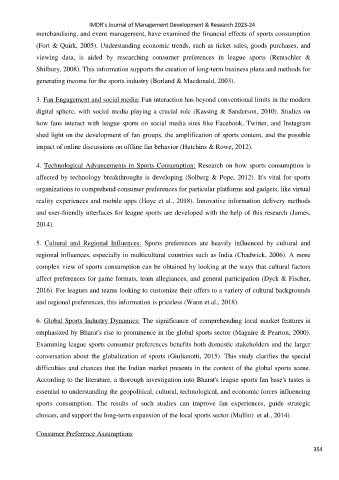Page 362 - IMDR JOURNAL 2023-24
P. 362
IMDR’s Journal of Management Development & Research 2023-24
merchandising, and event management, have examined the financial effects of sports consumption
(Fort & Quirk, 2005). Understanding economic trends, such as ticket sales, goods purchases, and
viewing data, is aided by researching consumer preferences in league sports (Rentschler &
Shilbury, 2008). This information supports the creation of long-term business plans and methods for
generating income for the sports industry (Borland & Macdonald, 2003).
3. Fan Engagement and social media: Fan interaction has beyond conventional limits in the modern
digital sphere, with social media playing a crucial role (Kassing & Sanderson, 2010). Studies on
how fans interact with league sports on social media sites like Facebook, Twitter, and Instagram
shed light on the development of fan groups, the amplification of sports content, and the possible
impact of online discussions on offline fan behavior (Hutchins & Rowe, 2012).
4. Technological Advancements in Sports Consumption: Research on how sports consumption is
affected by technology breakthroughs is developing (Solberg & Pope, 2012). It's vital for sports
organizations to comprehend consumer preferences for particular platforms and gadgets, like virtual
reality experiences and mobile apps (Hoye et al., 2018). Innovative information delivery methods
and user-friendly interfaces for league sports are developed with the help of this research (James,
2014).
5. Cultural and Regional Influences: Sports preferences are heavily influenced by cultural and
regional influences, especially in multicultural countries such as India (Chadwick, 2006). A more
complex view of sports consumption can be obtained by looking at the ways that cultural factors
affect preferences for game formats, team allegiances, and general participation (Dyck & Fischer,
2016). For leagues and teams looking to customize their offers to a variety of cultural backgrounds
and regional preferences, this information is priceless (Wann et al., 2018).
6. Global Sports Industry Dynamics: The significance of comprehending local market features is
emphasized by Bharat's rise to prominence in the global sports sector (Maguire & Pearton, 2000).
Examining league sports consumer preferences benefits both domestic stakeholders and the larger
conversation about the globalization of sports (Giulianotti, 2015). This study clarifies the special
difficulties and chances that the Indian market presents in the context of the global sports scene.
According to the literature, a thorough investigation into Bharat's league sports fan base's tastes is
essential to understanding the geopolitical, cultural, technological, and economic forces influencing
sports consumption. The results of such studies can improve fan experiences, guide strategic
choices, and support the long-term expansion of the local sports sector (Mullin). et al., 2014).
Consumer Preference Assumptions
354

